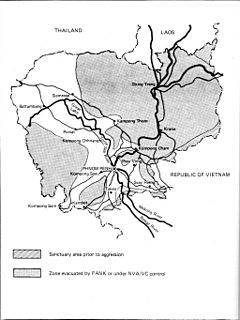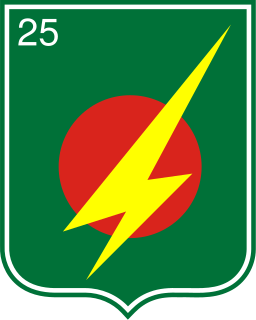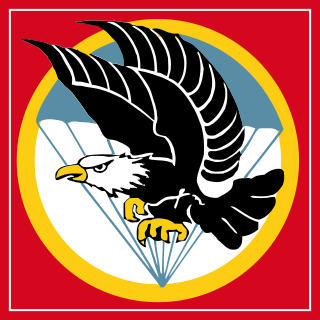
The Army of the Republic of Vietnam were the ground forces of the South Vietnamese military from its inception in 1955 to the Fall of Saigon in April 1975. It is estimated to have suffered 1,394,000 casualties during the Vietnam War.

The Cambodian campaign was a brief series of military operations conducted in eastern Cambodia in 1970 by South Vietnam and the United States as an extension of the Vietnam War and the Cambodian Civil War. Thirteen major operations were conducted by the Army of the Republic of Vietnam (ARVN) between 29 April and 22 July and by U.S. forces between 1 May and 30 June.

Operation Chenla II or Chenla Two was a major military operation conducted by the Khmer National Armed Forces (FANK) during the Cambodian Civil War from 20 August until 3 December 1971.

Operation Lam Son 719 or 9th Route – Southern Laos Campaign was a limited-objective offensive campaign conducted in the southeastern portion of the Kingdom of Laos. The campaign was carried out by the armed forces of South Vietnam between 8 February and 25 March 1971, during the Vietnam War. The United States provided logistical, aerial and artillery support for the operation, but its ground forces were prohibited by law from entering Laotian territory. The objective of the campaign was the disruption of a possible future offensive by the People's Army of Vietnam (PAVN), whose logistical system within Laos was known as the Ho Chi Minh Trail.

Operation Chenla I or Chenla One was a major military operation conducted by the Khmer National Armed Forces (FANK) during the Cambodian Civil War. It began in late August 1970 and ended in February 1971, due to the FANK High Command's decision to withdraw some units from Tang Kauk to protect Phnom Penh after Pochentong airbase was attacked.

The 18th Division was an infantry division in the III Corps of the Army of the Republic of Vietnam (ARVN). The U.S. Military Assistance Command Vietnam considered the 18th as undisciplined and it was well known throughout the ARVN for its "cowboy" reputation. In 1975 the 18th was made famous for its tenacious defense of Xuân Lộc, the last major battle before the Fall of Saigon.

The siege of Plei Me was the beginning phase of the first major confrontation between soldiers of the North Vietnamese People's Army of Vietnam (PAVN) and the U.S. Army during the Vietnam War. The lifting of the siege by South Vietnamese forces and American air power was followed by the pursuit of the retreating North Vietnamese from 28 October until 12 November, setting the stage for the Battle of Ia Drang.

The Vietnamese Rangers, properly known in Vietnamese as the Biệt Động Quân (En:Commando) and commonly known as the ARVN Rangers, were the light infantry of the Army of the Republic of Vietnam. Trained and assisted by American Special Forces and Ranger advisers, the Vietnamese Rangers infiltrated beyond enemy lines in search and destroy missions. Initially trained as a counter-insurgency light infantry force by removing the fourth company each of the existing infantry battalions, they later expanded into a swing force capable of conventional as well as counter-insurgency operations, and were relied on to retake captured regions. Later during Vietnamization the Civilian Irregular Defense Group program was transferred from MACV and integrated as Border Battalions responsible for manning remote outposts in the Central Highlands.

The 25th Division of the Army of the Republic of Vietnam (ARVN)—the army of the nation state of South Vietnam that existed from 1955 to 1975—was part of the III Corps that oversaw the region of the country surrounding the capital, Saigon. It was based at Củ Chi Base Camp to the northwest of the city.

The 9th Infantry Division of the Army of the Republic of Vietnam (ARVN)—the army of the nation state of South Vietnam that existed from 1961 to 1975—was part of the IV Corps that oversaw the southernmost region of South Vietnam, the Mekong Delta.

The Vietnamese Airborne Division was one of the earliest components of the Republic of Vietnam Military Forces. The Vietnamese Airborne Division began as companies organized in 1948, prior to any agreement over armed forces in Vietnam. After the partition of Vietnam, it became a part of the Army of the Republic of Vietnam. This division had its distinct origins in French-trained paratrooper battalions, with predecessor battalions participating in major battles including Dien Bien Phu and retained distinct uniforms and regalia. With the formation of an independent republic, the colonial paratroopers were dissolved, however regalia and aesthetics alongside the nickname "Bawouans" would be retained.
The 324th Division is an infantry division of the People's Army of Vietnam (PAVN) assigned to the 4th Military Region.
The Fall of Phnom Penh was the capture of Phnom Penh, the capital of the Khmer Republic, by the Khmer Rouge on 17 April 1975, effectively ending the Cambodian Civil War. At the beginning of April 1975, Phnom Penh, one of the last remaining strongholds of the Khmer Republic, was surrounded by the Khmer Rouge and totally dependent on aerial resupply through Pochentong Airport.

Operation Paul Revere IV was a United States Army operation of the Vietnam War that took place in the Plei Trap Valley, lasting from 20 October to 30 December 1966.

The attacks on Biên Hòa, Bien Hoa Air Base and Long Binh Post, occurred during the early hours of 31 January 1968 and continued until 2 February 1968. The attacks by Vietcong (VC) and People's Army of Vietnam (PAVN) forces were one of several major attacks around Saigon in the first days of the Tet offensive. The attacks were repulsed with the VC/PAVN suffering heavy losses, having inflicted minimal damage on the bases.
The Battle of Hồng Ngự took place from March to 4 May 1973 when North Vietnamese forces attacked the border town of Hồng Ngự in Dong Thap Province in order to interdict supply convoys into Cambodia. The attack was defeated by South Vietnamese forces assisted by United States bombing of North Vietnamese base areas in Cambodia.
Operation Sheridan Sabre was a security operation during the Vietnam War in Bình Long Province to prevent People's Army of Vietnam (PAVN) infiltration from Cambodia, that took place from 7 November 1968 to 4 April 1969.
Operation Pennsylvania Square was a security operation during the Vietnam War conducted by the 198th Light Infantry Brigade, 23rd Infantry Division in Quảng Tín Province from 29 June 1970 to 1 March 1971.
The 20th Tank Regiment was a unit of the Army of the Republic of Vietnam (ARVN), the South Vietnamese army. The 20th Tank Regiment was organized on 31 July 1971 and soon saw extensive combat during the 1972 Easter Offensive.
The Easter Offensive in southern Cambodia and the Mekong Delta was part of the People’s Army of Vietnam (PAVN)’s Easter Offensive of 1972 and saw PAVN and Viet Cong (VC) engage the Army of the Republic of Vietnam (ARVN) and Khmer National Armed Forces (FANK) supported by the United States along the southern Cambodian border with South Vietnam and in the Mekong Delta of South Vietnam. The offensive failed to seriously disrupt the vital South Vietnamese supply routes in the Delta or the pacification efforts there.











